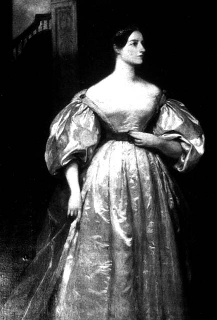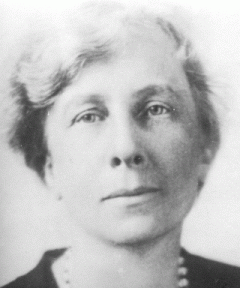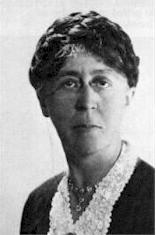
|
Management Pioneers: Women as Early Contributors to the Management Discipline by C. Alan Parks
|
Long before the term "glass ceiling" was coined to describe the invisible but very real barrier women face in the climb to top management, there were a number of notable women who simply ignored (or overcame) all obstacles and became significant contributors to the field of management. Among them were three individuals whose unique and lasting accomplishments still affect the way managers look at information, productivity and people. Augusta Ada (Byron), Lillian Moller Gilbreth, and Mary Parker Follett are among the women who made an impact on the management discipline in spite of the cultural constraints of the era.
| In 1834, Ada met mathematician and inventor (The cowcatcher was one of his many inventions.) Charles Babbage, creator of an early mechanical calculating machine, the Difference Engine, and the more ambitious Analytical Engine, a machine strikingly similar to the computers of today. Ada became fascinated with the possibilities of the Analytical Engine and, as a mathematician, she immediately understood its potential. After Babbage presented his Analytical Engine concept at a conference in Italy that resulted in the publication of "Sketch of the Analytical Engine" by Italian Luigi Menabrea, with the encouragement of Babbage, Ada began translating the article into English, annotating it extensively. [Kim & Toole, 1999] |
Babbage wrote the first programs for the un-built Analytical Engine, but it was Ada, through her notations, who devised the majority of detailed programs for the device. (Ada had by then become the Countess of Lovelace as a result of her marriage to William King, Earl of Lovelace.) Ada noted, among other things, that the Analytical Engine had the capacity to follow if/then scenarios (conditional branching), and reuse the "programs" stored on punched cards. Ada wrote a number of complex programs for the machine, including one to compute Bernoulli numbers, and she recognized a wide variety of applications for her programs and the device.
Ada’s fascination with the Analytical Engine and its potential was tempered by a thorough understanding of what the machine was, and was not, capable of doing. She insisted that the machine did not "think," it merely followed instructions: "The Analytical Engine has no pretensions whatever to originate anything; it can do whatever we know how to order it to perform." [Wren, 1994]
Her mathematical and literary knowledge allowed her to describe Babbage’s ideas and her own and write complex applications for the device. The application she wrote to compute Bernoulli numbers is recognized as the first "computer program," and in recognition of this contribution, the U.S. Department of Defense in 1979 named a software language "Ada" in her honor.
As Lord Byron’s daughter, Ada’s life acquired the romance and excitement stemming from her heritage, but as a competent student of mathematics, she quickly earned a name for herself as one who thoroughly understood Babbage’s concepts and could explain them better than he could. [Wren, 1994] She died at the age of 36 in 1852, leaving her notations as a precursor of modern computer programs that would only be developed nearly a century later.

Lillian Moller Gilbreth
Lillian Moller Gilbreth, born in 1878, is considered the First Lady of Management. [Wren, 1994] She succeeded in balancing a busy home life with an outstanding career in management. Like Augusta Ada, Lillian Gilbreth’s work in the field of management began in partnership with a man (her husband, in this case), but her contributions stand alone as significant due to their groundbreaking insight into the psychology of the individual.
Lillian met Frank Gilbreth, then a construction contractor, in 1902 while on vacation following the completion of her masters degree. [San Diego Supercomputer Center, 1997] Lillian and Frank were married in 1904 and began a synergistic partnership that would produce a number of new concepts related to worker efficiency and productivity and, not incidentally, twelve children. As the family grew, Lillian’s graduate thesis, "The Psychology of Management," was published under the name L.M. Gilbreth, a requirement of the publisher, who did not wish to disclose that the author was a woman. [Wren, 1994] She eventually completed her Ph.D. at Brown University.
An advocate of Frederick Taylor’s Scientific Management, Frank Gilbreth was concerned with the operational aspects of worker efficiency, using photography to study the various motions as workers completed tasks to achieve the greatest economy of effort. His studies, for example, helped reduce the number of motions in the bricklaying process from 18 – ½ to 4, significantly improving output. [Wren, 1994] The Gilbreths’ believed that worker efficiency in motion helped the worker as much as it did management. Lillian’s perspective as an engineer and industrial psychologist favored the worker’s viewpoint; she believed that efficiency in motion was really a portion of a well-designed job that resulted in the enhanced well-being of the worker. This was a particularly revolutionary concept at a time when the general sentiment among labor leaders was that Scientific Management exploited workers in order to enhance productivity. Lillian and Frank were among the first to study the effects stress and fatigue on workers and suggest ways to reduce fatigue through efficient motion. [Miller and Lemons, 1998]
The efficiency in motion concepts developed by Frank and Lillian Gilbreth were employed liberally at home, with the children as (often reluctant) participants. Lillian set up a Family Council to help manage household affairs, carefully monitored waste and inefficiency, and subsequently wrote a number of books on the topic. [Benner, 1999] Some of the more extreme "experiments" (especially Frank’s) at home led son and daughter, Frank Jr. and Ernestine, to co-author the books "Cheaper by the Dozen," and "Belles on Their Toes," published in the late 1940’s, they chronicled some of the more humorous events in a home run by efficiency experts. Unfortunately, Frank Sr. died suddenly in 1924, and Lillian found herself with twelve active children to take care of by herself and an equally active business to manage.
Lillian managed the family and the family business masterfully. No longer needing to conceal her gender, she left the "L.M." behind and, as Lillian (or Lillie), focused her consulting skills on helping businesses simultaneously achieve the goals of increased worker efficiency and reduced worker fatigue. She helped companies improve efficiency through technology and enhance working conditions (more "happy minutes," as she would describe it) by helping top management understand the importance of the psychological aspects of work from the workers’ point of view. [Benner, 1999]
Lillian’s consulting work continued for decades, including significant work with General Electric and other companies. She became the first women voted into membership in the American Society of Mechanical Engineers, and in 1935 became a professor of management at Purdue university and its only female professor in the engineering school. [San Diego Supercomputer Center, 1997] At Purdue she continued to preach the gospel of efficiency and continued the motion studies, and later, during World War II, the Gilbreths’ method of filming and using these films for employee training was widely used. She garnered over a dozen honorary degrees along with the prestigious Hoover Medal, awarded in 1966 by the American Society of Civil Engineers. [San Diego Supercomputer Center, 1997] Lillian died in 1972 at the age of 92, leaving a legacy of productivity improvements for industry and a richly deserved reputation as a key contributor to the management field.

Mary Parker Follett
Mary Parker Follett, born in 1868, was an advocate of employee empowerment, constructive use of conflict in labor–management relations, and flatter organizational structures decades before these concepts became fashionable in modern management theory. [Ettore, 1995] She was a social advocate, philosopher, political activist and visionary. [McLarney & Rhyno, 1999] Her definition of leadership centered on the concept that formal authority should not determine leadership, but rather that the needs of the particular situation dictate the role of the leader. The group was the focus of her thinking; the individual could only realize his or her true self through reciprocal interaction as a member of a group, the main goal of which was to achieve integrative unity. [Wren, 1994]
Follett held the unusual notion that harmony could be achieved from the proper use of conflict, a theory that was politically incorrect for its time and even incomprehensible in an era dominated by men who believed the purpose of conflict was to vanquish the other party. [Anonymous, 1997] She believed there were four means of conflict resolution: voluntary submission of one party; struggle and victory of one party over another; compromise; and her favored "integration," which in involved finding a solution that satisfied both parties without compromise or domination. [Wren, 1994]
This notion of constructive conflict was one of the theories discussed in Follet’s 1924 book, Creative Experience. She sought integration as a solution due to the negative and continuing consequences of compromise or domination. Follet held that collective bargaining was a divisive process that emphasizes differences, rather than common purpose, and one that ultimately results in compromise, rather than an integrative solution focused on that common purpose and goals. [Wren, 1994]
Follet also noted that knowledge and experience, not formal authority, dictated the leadership role in any given situation, with individuals being responsible for work, and not to someone. [Wren, 1994] She believed that leadership evolved in the group situation and that the leaders emerge by understanding group members’ capabilities and integrating them to achieve the common purpose.
The leader in the group situation simultaneously influences and is influenced by group members. This is a concept Follet called "circular response." She believed that the CEO should define the organization’s purpose and coordinate its activities and anticipate its future. [McLarney & Rhyno, 1999; Wren, 1994] She believed that effective leadership depended on constructively active group members who do not serve the leader, but rather the common purpose.
Mary Parker Follett also anticipated the concept of social responsibility as part of any successful business enterprise. In her 1930 article, "Leader and Expert" she noted that the CEO "...must understand that whatever is good for the community is good for the business in the long run." [McLarney & Rhyno, 1999, 299] She believed that management was a great responsibility given that businesses functioned as part of the greater whole of society. Follet also emphasized coordination and control as a means to achieve the goals of a group united in a common purpose.Mary Parker Follet--clearly a leading management thinker of her time--died in 1933 after an extensive career in management. Her concepts of conflict resolution, leadership, coordination and control, and group organization served as a prologue for modern management thought.
Conclusion
References
Anonymous (1997). "A Guru Ahead of Her Time." Nation’s Business, 85, 24.
Benner, D. (1999). Engineering hero: Lillian Moller Gilbreth. Available on line at: http://www.njspe.org/75a_Gilbreth.htm
Ettore, B. (1995). "A Woman for All Seasons." Management Review, 84, 7.
Kim, E. E. & Toole, B. A. (1999). "Ada and the First
Computer." McLarney, C. & Rhyno, S. (1999). "Mary Parker Follett:
Visionary Leadership and Strategic Management." Women in Management
Review, 14, 292-303. Miller, T. R. & Lemons, M. A. (1998). "Breaking the Glass
Ceiling: Lessons from a Management Pioneer." S.A.M. Advanced Management
Journal, 63, 4-10. San Diego Super Computer Center (1997). Toole, B. A. (1998). Ada: The Enchantress of
Numbers.
Wren, D. A. (1994). The
Evolution of Management Thought. New
York: John Wiley & Sons.